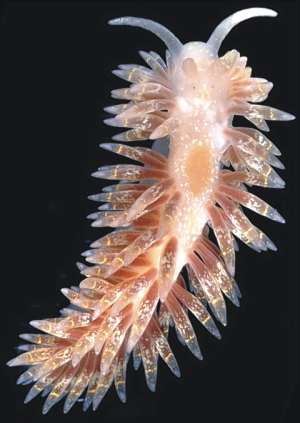
Spurilla macleayi
(Angas, 1864)
Order: NUDIBRANCHIA
Suborder: AEOLIDINA
Family: Aeolidiidae
DISTRIBUTION
Temperate Australia, from southwstern Australia to nthn New South Wales.
PHOTO
Tesselated Pavement, Pirates Bay, Tasman Peninsula, Sthn Tasmania, 15 February 1984. AM C141245 3 specimens together under rock at low tide. 10-22mm long alive. Photo: Bill Rudman
The shape is typical of most members of the Aeolidiidae, with a broad foot and tentacular anterior foot corners. The relatively short and fusiform cerata are numerous and lie closely packed to cover most of the dorsum behind the rhinophores except for the midline. The precardiac cerata are arranged in a double arch on each side while the cerata behind the pericardium are arranged in one or two single arches and then a series of up to 6 sloping single rows. The tapering rhinophores bear prominent tranverse wrinkles along most of their length. The notum behind the rhinophores and over the pericardium is clear of cerata. Behind the pericardium the clear space narrows but a distinct median gap between the cerata is retained all down the body. The foot, oral tentacles, rhinophores and head are translucent whitish but there can be varying degrees of orange or red pigmentation on the rhinophores and head region. On the head their can be an opaque white patch which is sometimes tinged with orange. Between the rhinophores and pericardium swelling there can be an opaque white diamond shape which can also be tinged with orange. A similar shaped patch can be found in the midline between each ceratal group. The pericardium is often covered by an orange patch. There are often white streaks down each side between the ceratal groups. In general the background colour of the animal, including the cerata, is dependent on the colour of the internal viscera so it can vary from a pale translucent orange or brown to a dark brown colour. The cerata have a characteristic subapical yellow ring. Below this ring there can often, but not always, be traces of two bluish-white rings. The bluish white rings are usually broken and can sometimes be reduced to irregular dashes and spots. There can sometimes be an orange tinge on the ceratal skin. The digestive gland reaches to about the level of the subapical yellow ring. Above this yellow ring the translucent white cnidosac is clearly visible.
Although it is reported to grow to 35mm in length, specimens seldom are larger than 20mm. It is usually found intertidally or in the shallow sublittoral, where it feeds on sea anemones. The eggs are large [see #12136] and give rise to direct developing young which hatch out of the egg mass as small crawling slugs.
References:
• Angas, G. F. (1864) Description d'especes nouvelles appartenant a plusieurs genres de Mollusques Nudibranches des environs de Port-Jackson (Nouvelle-Galles du Sud), accompagnee de dessins faits d'apres nature. Journal de Conchyliologie, 3, 12: 43-70, pls. 4-6.
• Burn, R.F. (1962) Descriptions of Victorian nudibranchiate mollusca, with a comprehensive review of the Eolidacea. Memoirs of the National Museum of Victoria, 25: 95-128.
• Burn, R.F. (1969) A memorial report on the Tom Crawford collection of Victorian Opisthobranchia. Journal of the malacological Society of Australia, 12: 64-106.
Rudman, W.B., 2004 (January 29) Spurilla macleayi (Angas, 1864). [In] Sea Slug Forum. Australian Museum, Sydney. Available from http://www.seaslugforum.net/find/spurmacl
Related messages
Spurilla macleayi from northeastern New Zealand
January 12, 2007
From: Ian Skipworth
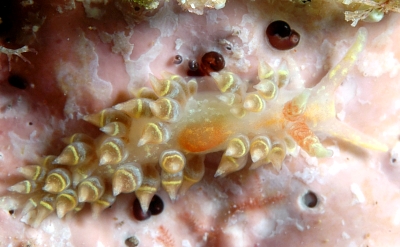
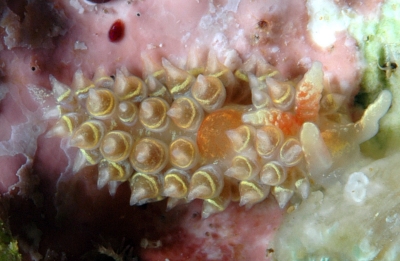
Hi Bill
This slug is not one I've come across before and I hope you can help with its identification. It would seem to be similar to some Janolus species but is certainly quite different from J. mokohinau, J. ignis and J. eximius with which I am familiar.
Locality: Poor Knights Islands, 12 m, New Zealand, Pacific Ocean, 07 January 2007, Rocky reef. Length: 9 mm. Photographer: Ian Skipworth
Thanks in advance for your help.
Cheers
Ian
ianskip@xtra.co.nz
Skipworth, I.R., 2007 (Jan 12) Spurilla macleayi from northeastern New Zealand. [Message in] Sea Slug Forum. Australian Museum, Sydney. Available from http://www.seaslugforum.net/find/19188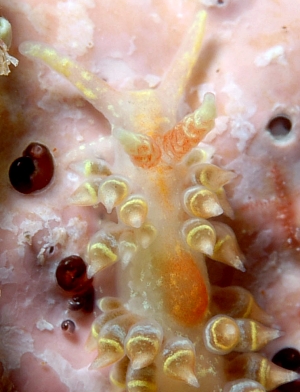
Dear Ian,
This animal does look quite like a zephyrinid, but I would have said Caldukia rather than Janolus. However it is an aeolid, Spurilla macleayi. Some species of aeolid retract their cerata like this when they are 'resting'. You'll see in your upper photo, in which the animal is starting to crawl, that the cerata area beginning to elongate.
This species is common in southeastern Australia and also recorded from throughout New Zealand. This record is very welcome because it shows a specimen with yellow rings on the cerata and the orange-red patch over the heart - a colour form not recorded from New Zealand before, but common in Australia.
Best wishes,
Bill Rudman
Re: Spurilla faustina? from New Zealand
November 22, 2006
From: Jeff Goddard
Concerning message #18264:
Hi Bill,
Kimberley Seaward's aeolid [message 18264] reminds me of the Spurilla macleayi I found near Wellington in 2005 [message 14713], and as a reminder, in your response to my message on that find, you stated that S. macleayi and S. faustina are synonyms.
Best,
Jeff
goddard@lifesci.ucsb.edu
Goddard, J.H.R., 2006 (Nov 22) Re: Spurilla faustina? from New Zealand. [Message in] Sea Slug Forum. Australian Museum, Sydney. Available from http://www.seaslugforum.net/find/18471Dear Jeff,
Since it's a while since I returned from Europe I can't blame jetlag ... You are quite right. I did think of Spurilla macleayi, but my image of that species is of eastern Austrakian animals which usually have a ring of gold around the upper part of each ceras and distinct orange marks on the dorsum - both lacking in Kimberley's animal. Your animal from Wellington - which I forgot - is a very good link between Kimberley's animal and eastern Australian animals. Thanks for reminding me
Best wishes,
Bill Rudman
Spurilla faustina? from the South Island, New Zealand
November 21, 2006
From: Kimberley Seaward
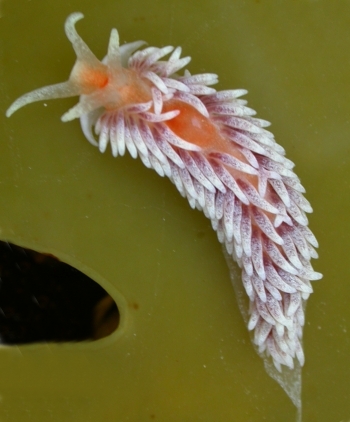
Dear Bill,
Here is another photo of a nudibranch I took on my recent trip to Moeraki. It was quite abundant, although I haven't even started to look to find out what they are.
Locality: Moeraki, Otago, South Island, New Zealand, east coast. Intertidal. 02 November 2006, Intertidal . Length: approx 3 cm. Photographer: Kimberley Seaward.
Thanks
Kimberley
kimberley.seaward@canterbury.ac.nz
Seaward, K.J., 2006 (Nov 21) Spurilla faustina? from the South Island, New Zealand. [Message in] Sea Slug Forum. Australian Museum, Sydney. Available from http://www.seaslugforum.net/find/18264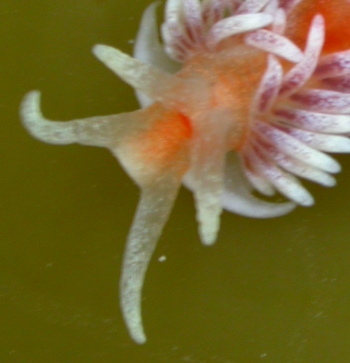
Dear Kimberley,
This animal has similarities in colour to the aeolid Jason mirabilis, but the cerata don't seem to be arranged in groups, as is found in that species, and the rhinophores seem too smooth. It looks quite like a member of the family Aeolidiidae and is possibly Aeolidiella faustina Bergh, 1900 which Michael Miller (2001) transferred to the genus Spurilla. Unfortunately our knowledge of that species is based on Bergh's preserved animals and 3 or 4 available to Miller. However in your photo the cerata seem to be arranged in transverse rows, while Miller describes them as being in shallow arches on each side. Most specimens of S. faustina are known from southern New Zealand. I'll contact Michael Miller and see what he thinks.
- Miller, M. C. (2001) Aeolid nudibranchs (Gastropoda: Opisthobranchia) of the family Aeolidiidae from New Zealand waters. Journal of Natural History 35: 629-662.
Best wishes,
Bill Rudman
Spurilla macleayi from New Zealand - with large eggs
September 6, 2005
From: Jeff Goddard
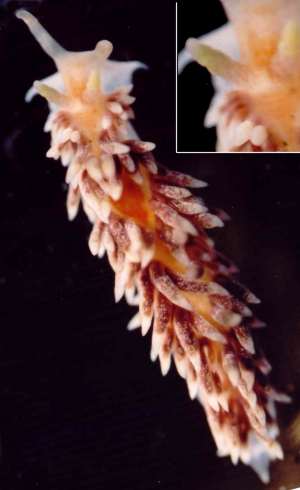
Hi Bill,
I was in Wellington, New Zealand recently, and while there I had a chance to do a little tide-pooling. I only found one species of dorid nudibranch (Aphelodoris luctuosa), one species of aeolid and one species of notaspidean, but the latter two finds have turned out to be fairly interesting, and I wanted to report here on the aeolid, which I believe is Spurilla macleayi. I found two specimens, both about 25 mm long and one of which was next to the two egg masses in the accompanying image (the previous day at the same locality I had found an identical egg mass, but no suspect as to who had laid it, so I noted the very large eggs and recorded in my notebook that they were probably laid by an aeolid). Given the proximity of the one specimen to the egg masses, as well as the paucity of other species of nudibranchs, I was confident that the eggs were laid by the aeolid I found. This was further confirmed when I later saw your message of 9 February 2004 [#12136] on the eggs and development of Spurilla macleayi. Small, unidentified anemones were common in the under-rock habitat in which I found the aeolids and were presumably their food.
Locality: Tarakena Bay, Wellington, New Zealand. Intertidal. Length: 25 mm (adult aeolid). 21 August 2005. Rocky shore, low intertidal pool. Photographer: Jeff Goddard
I collected the two egg masses and was able to borrow a microscope and micrometers from Victoria University of Wellington (thank you, Jonathan Gardner and Chad Hewitt). The embryos in one egg mass were slightly out of round, very yolky and opaque and averaged 480 microns in the longest dimension. They had relatively small, bluntly rounded velar lobes, no sign of a shell and occurred singly in capsules averaging 550 x 505 microns. Embryos in the second egg mass were at an earlier, but indeterminable stage of development and averaged 500 x 440 microns in size and also occurred one per capsule. In my experience the early embryos of opisthobranchs are usually close in size to that of the uncleaved eggs; these embryos therefore developed from some of the largest, if not the largest, eggs known in the Opisthobranchia.
These measurements complement your previous message on the direct development of this aeolid. Unfortunately, my visit was a short one, and I was not able to observe further the development of the embryos. I hope to return to your region before too long and continue there my comparative studies of developmental mode in opisthobranchs.
On a taxonomic note, I noticed that Miller (2001) does not include Spurilla macleayi from New Zealand, but does imply that it may be the same as S. faustina, which he does include from New Zealand. However, the Sea Slug Forum mentions the similarity of S. faustina to Aeolidiella drusilla, which is also described by Miller (2001) from New Zealand. Based on the images in the Sea Slug Forum, as well as Miller's (2001) description, A. drusilla appears to have a much wider foot than S. macleayi and S. faustina. Are macleayi and faustina synonyms, separate from A. drusilla?
-
Miller, M.C. (2001) Aeolid nudibranchs (Gastropoda: Opisthobranchia) of the family Aeolidiidae from New Zealand waters. Journal of Natural History, 35: 629-662.
Best wishes,
Jeff
goddard@lifesci.ucsb.edu
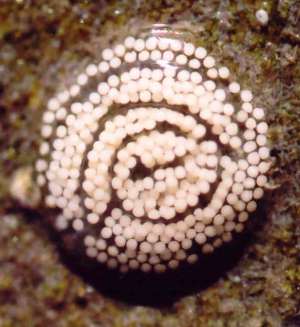
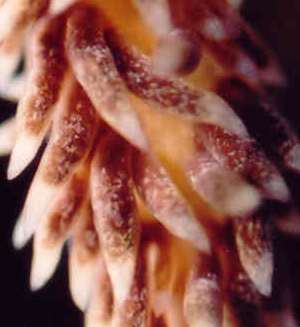
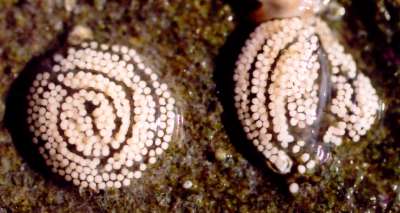
Dear Jeff,
This was certainly an excellent animal to find on a short visit to New Zealand, and its egg mass was an even more excellent bonus. It certainly is the animal we call Spurilla macleayi in Sydney, which is the type locality of the species. The drusilla / faustina problem is just another example of the chaos caused by naming species on the basis of single preserved decolourised animals. I can't even begin to understand why someone, even in 1900, could believe there was any point in giving these 2 specimens names, other than to build a score list of species names. We sometimes pay a high price for others egos. When Miller recognised the similarity of S. faustina to S. macleayi but because Burn considered the two were probably different, erred on the side of caution and identified his specimens from New Zealand as S. faustina. However your photos, and his description of the living animals are a clear match to some of the colour forms of Spurilla macleayi, and his radula drawing matches Bergh's S. faustina [see message #4159] and my SEM of typical S. macleayi [see message #12145]. I have discussed A. drusilla and S. faustina in earlier essages [#4159]. Because of the confusion I have A. drusilla on the Forum as Aeolidiella cf. drusilla but should really be confident and remove the 'cf'.
Yes Spurilla macleayi and Bergh's S. faustina are clearly synonyms. As Miller shows, it is quite different anatomically from A. drusilla, in many aspects of the body shape, including the cerata arranged in single rows in A. drusilla, rather than arches, and anatomically, in the radular morphology. As I said at the start of my comments, you couldn't have picked a better species to find.
Best wishes,
Bill Rudman
Anemone-feeding nudibranchs in South Australia
February 5, 2005
From: Dennis Hutson
Dear Bill,
Thank you for your assistance. I keep a temperate aquarium with all manner of life. I have an abundance of anemones. Which nudibranchs and where would I be able to find them locally in South Australian waters that would eat the anemones?
Dennis Hutson
dghutson@ozemail.com.au
Hutson, D.G., 2005 (Feb 5) Anemone-feeding nudibranchs in South Australia. [Message in] Sea Slug Forum. Australian Museum, Sydney. Available from http://www.seaslugforum.net/find/13076Dear Dennis,
The most likely anemone eaters would be certain species of aeolid of the family Aeolidiidae. Some semm to have quite specific preferences but others seem to be more catholic in their tastes. One relatively common one would be Anteaeolidiella indica. In South Australia they tend to look like those in Denis Riek's recent message. Another possibility is Spurilla macleayi. If you look at the Fact Sheet and other messages I have posted on S. macleayi, it should give you enough background information to recognise one or two if you find them. These species both range from the intertidal to about 5 m and are found under stones. Unfortunately there is no guarantee you will find them but it's worth keeping an eye out for them. There are other aeolids you will run across but most of them feed on hydroids or soft corals.
Best wishes
Bill Rudman
Spurilla macleayi from Tasmania
February 9, 2004
From: Bill Rudman

To illustrate colour variation in Spurilla macleayi here is an example from southern Tasmania, Australia
PHOTOS: Tesselated Pavement, Pirates Bay, Tasman Peninsula, Sthn Tasmania, 15 February 1984. AM C141245 3 specimens together under rock at low tide. 10-22mm long alive. Photos: Bill Rudman
In this animal the dorsum is translucent clear with opaque bluish-white elongate patches. There is a prominent translucent orange mark over pericardium and a smaller orange mark in the following interceratal space. The rhinophores have opaque yellowish white markings on the upper third of their length and they are irregularly wrinkled.
The ceratal wall is transparent with the brown digestive gland showing through. At the tip, the translucent white cnidosac is clearly visible. The most distinctive epithelial marking on the cerata is a subterminal yellow ring, which is usually entire, but can be broken. Above this yellow ring are a few scattered opaque bluish white spots and below it, there are many more, some merging into larger white patches and in other cases forming one or more irregular broken rings of white. The radula is illustrated separately [see #12145].
Bill Rudman


Spurilla macleayi from Sydney
February 9, 2004
From: Bill Rudman

To illustrate colour variation in Spurilla macleayi here is an example from Sydney, New South Wales, Australia
PHOTOS: Bungan Head, Sydney, NSW, Australia, intertidal, 29 November 1986. approx 20mm long alive. AM C151992. Photos: Bill Rudman.
This animal is similar to Tasmanian animals [message #12134] but the body has much more orange-red pigmentation on the dorsum, and less bluish-white pigmentation on the cerata.
This animal was kept for 2 weeks in an aquarium and during that time it ate 5-6 sea anemones [Anthothoe albocincta]. In that time it laid and egg ribbon which is described separately [message #12136]
Bill Rudman


Spurilla macleayi - eggs & development
February 9, 2004
From: Bill Rudman


PHOTOS: Bungan Head, Sydney, NSW, Australia, intertidal, 29 November 1986. approx 20mm long alive. AM C151992. Photos: Bill Rudman
Here are a number of observations showing that Spurilla macleayi is a direct developer. The accompanying photos are of an egg ribbbon laid by the animal from Bungan Head, Sydney, described earlier [message #12135]. The egg ribbon was not measured but the size of the eggs suggest that it is a direct developer. Unfortunately the date the egg ribbon was laid was not noted but my colleague, Ian Loch, made the following notes on the development of the larvae.
• 17 December - no shell but larvae spinning within capsule, 'velar' lobes visible
• 24 December - egg mass breaking down, larvae crawling rather than spinning
• 30 December - young emerging from egg ribbon as crawling slugs.
I have observed similar egg ribbons on two other occasions.
• Ulverstone, Tasmania, 21 February 1984. 20mm long animal. AM C141294. - Laid an egg ribbon, very similar to the one from Sydney in the accompanying photo, and the larvae developed small non-ciliated velar lobes. The egg ribbon diameter was approximately 6mm.
• WEst Head, Flinders, Westernport Bay, Victoria, 2 May 1986. under rocks at low tide. 6 animals 12-16mm long alive. AM C149499. - One animal laid a single string egg ribbon of very large eggs in a dish.
Bill Rudman
Rudman, W.B., 2004 (Feb 9) Spurilla macleayi - eggs & development. [Message in] Sea Slug Forum. Australian Museum, Sydney. Available from http://www.seaslugforum.net/find/12136Spurilla macleayi - colour variation
February 9, 2004
From: Bill Rudman
Here are photos of three more animals to accompany my other messages illustrating colour variation in Spurilla macleayi [see messages #12134, #12135].
A. Goat Island Beach, Ulverstone, Nthn Tasmania 20 Feb 1984, intertidal;
12mm long alive, AM C141279. Photo: Bill Rudman. - The main colour in this specimen is the opaque cream white, which forms a patch on the head, another behind the rhinophores, a ring around the pale ornage pericardium, and then smaller patches between each group of cerata down the dorsal midline. In this animal, the usually characteristic subterminal yellow ring on the cerata is reduced to a broken series of dashes.
B. 7 Kms south of Mallacoota, Victoria, Australia. 28 February 1982. 12mm long. AM C138022. Photo: Bill Rudman. - In this animal the boody wall is translucent with almost no sign of opque white speckling. There is some orange dusting on the head and there is a very bright orange pericardial patch. On the cerata, the yellow ring is the only epithelial colour.
C. Goat Island Beach, Ulverstone, Nthn Tasmania, Australia. 20 Feb 1984, intertidal; 15mm long alive. AM C141279. Photo: Bill Rudman. - Found with the animal A, the opaque white patching down the dorsal midline is more developed than in the other animal.
It has been suggested that the colour variation in this species may indicate a complex of species. However it is equally likely that with a direct developing larval stage, local colour forms are likely to occur through restricted gene flow. All animals show parts of the colour pattern. nearly all have the yellow subterminal ceratal ring, and most have some indocation of an orange patch over the pericadium. The other major feature of the colour pattern - a white patch on the head, another behind the rhinophores, and a series of white patches in the dorsal midline in the interceratal spaces - is less common, but traces of the pattern are often present.
Best wishes
Bill Rudman
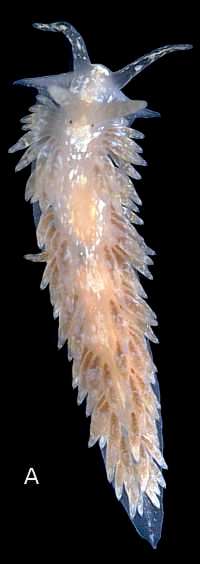
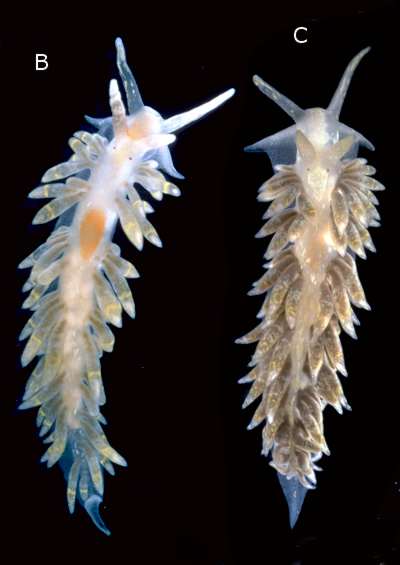
The radula of Spurilla macleayi
February 9, 2004
From: Bill Rudman
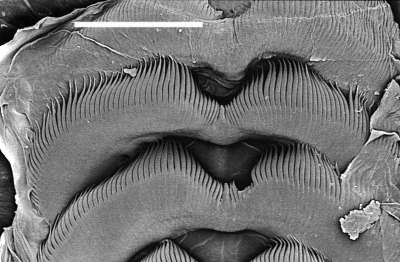
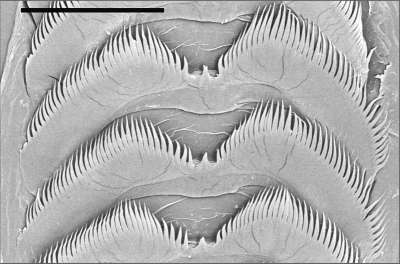
Here are scanning electron micrographs of the radula of two specimens of Spurilla macleayi.
Upper: Tesselated Pavement, Pirates Bay, Tasman Peninsula, Sthn Tasmania, 15 February 1984. 3 specimens together under rock at low tide. 19-22mm long alive. AM C141245 [see #12134]
Lower: Long Reef, Sydney, NSW, Australia. 3 April 1985. 17mm long alive. AM C145674 - Radular formula 21 x 0.1.0
Scale bars = 100 microns. Photos: Geoff Avern.
Best wishes
Bill Rudman
Spurilla macleayi - pink eggs?
February 9, 2004
From: Rachel Przeslawski
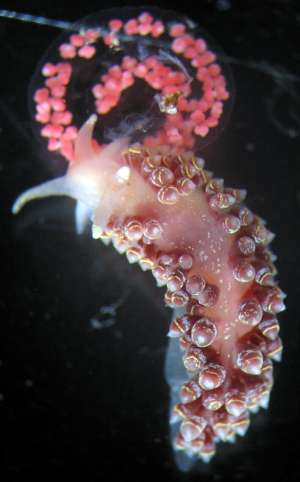
Hi Bill,
I was wondering if you could identify this little guy. I found the egg mass first under an intertidal boulder at Bass Point, nea Wollongong, New South Wales in December. The adult was very near to the egg mass, but it wasn't until I looked at it under the microscope that I was quite confident he had laid the large bright pink eggs I had originally seen. They were easily observed within the slug although not quite so easily captured on the camera!
Thanks for your help!
Rachel
rachelp@uow.edu.au
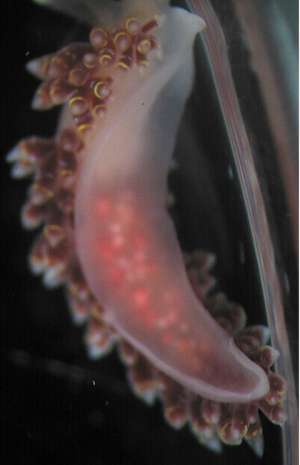
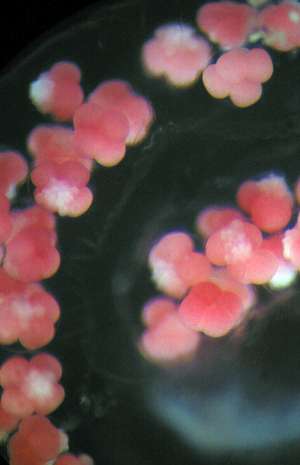
Hi Rachel,
This is Spurilla macleayi, and aeolid endemic to south eastern Australia. I tend to agree about the eggs but I have never seen it lay pink ones like this.
This is one of many species which I have not yet posted on the Forum so your question has forced me to fill the gap. I have posted some messages showing colour variation [see messages #12134, #12135, #12137] and observations on its eggs and development [see message #12136].
It is a direct developer and the egg ribbons I have seenare similar to yours but the eggs have been white. I guess they could range in colour from pink to white but I think you would need to see it lay one to be sure. Your animal certainly has dark red contents in the digestive gland suggesting it has been feeding on the deep red anemone Actinia tenebrosa. I have only found it feeding on the much lighter coloured Anthothoe albocincta, but if it does eat Actinia tenebrosa then it is possible that the pink pigmentation on the eggs is from the sea anemone. Obviously something that would need checking
Cheers
Bill Rudman
